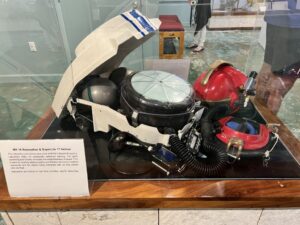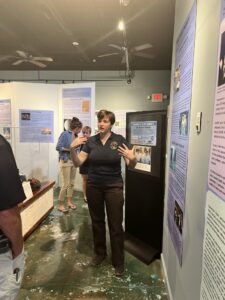In the ongoing chronicle of human discovery, we seldom stop to appreciate the routine launching of rockets and satellites amidst the cacophony of terrestrial turmoil. It wasn’t until Nazi Germany, during the closing stages of World War II, sent warhead-laden rockets careening into Britain, that the world truly recognized the dual-edged potential of these skyward technologies. Ironically, it was conflict, not the pursuit of knowledge, that catalyzed these initial advancements.
The History of Diving Museum (HDM) in Islamorada, Florida, delves into this unique intersection of rivalry, science, and the indomitable human spirit, through its latest exhibit: Aquanauts to Astronauts. This carefully curated collection chronicles the lineage of space exploration and emphasizes the integral role of underwater training in preparing astronauts for the weightless expanses of space.
The exhibit highlights significant milestones, starting from the U.S.’s 1947 launch of fruit flies aboard a rocket to measure radiation’s effects on living organisms, culminating in the testing on Rhesus Macaque monkeys, precursors to human space travel.
Notably, the exhibition highlights the National Atmospheric and Space Administration’s (NASA) Neutral Buoyancy Lab in Houston, Texas, home to one of the world’s largest swimming pools. Containing 6.2 million gallons of water and housing a life-size replica of a space station, the pool provides astronauts a simulated weightless environment for training. This crucial preparation method illustrates the potent convergence of diving and astronautical training; the divers who accompany and train these spacefarers in their aquatic tasks play a vital role in the success of space missions.

The display delves into the uncanny progression from rocket launches to moonwalks, charting the thrilling Cold War race for cosmic supremacy, where the United States and the Soviet Union vied to claim the celestial frontier.
The exhibit does not overlook the significance of attire. Much like the need for specialized suits in deep-sea diving, Extra Vehicular Activity suits (EVAs) are crucial in protecting spacewalkers from potential hazards, including meteorite debris and extreme temperature fluctuations. The exhibit highlights the intricacies of these suits, comparing the experience of astronauts working at a speed of five miles per second to a high-speed journey between Boston and Philadelphia in just sixty seconds.

Key figures are not forgotten. The exhibit honors the remarkable achievements of individuals such as Dr. Kathy D. Sullivan, the first woman to both walk in space and reach the deepest part of the ocean, and Valentina Tereshkova, the first woman in space.
Also on display is NASA’s MK 16 rebreather and SuperLite 17 helmet, used for underwater astronaut training. This equipment, similar to those used by modern divers, underscores the integral connection between diving and space exploration.


NASA’s Extreme Environmental Mission Operation (NEEMO), located off Key Largo, Florida, is another key focus. The underwater habitat provided astronauts with simulated space-like conditions, accentuating the importance of underwater diving to space exploration.
The exhibit strikes a poignant contrast between the pressure dynamics of space travel and underwater diving, providing a fascinating examination of how the human body responds differently to these environments.
The Aquanauts to Astronauts exhibit invites visitors to immerse themselves in a forgotten chapter of space exploration, reminding us of the humbling reality that our knowledge of space often surpasses our understanding of our own oceans. This human thirst for exploration, while awe-inspiring, highlights the necessity for balance in our quests, as the health of our oceans remains vital to our survival.
For more information on the Astronauts to Aquanauts exhibit, visit www.divingmuseum.org and navigate to the ‘Exhibits’ section and then ‘Virtual Tour’. The HDM is open daily from 10 am to 5 pm Eastern Time Zone, located at Mile Marker 83, 82990 Overseas Highway, Islamorada, FL 33036. You may also reach them at 305.664.9737.
The Author, John Christopher Fine, can be reached at: moc.o1743811626nuj@21743811626enifc1743811626nhoj1743811626 or 561.364.8593







